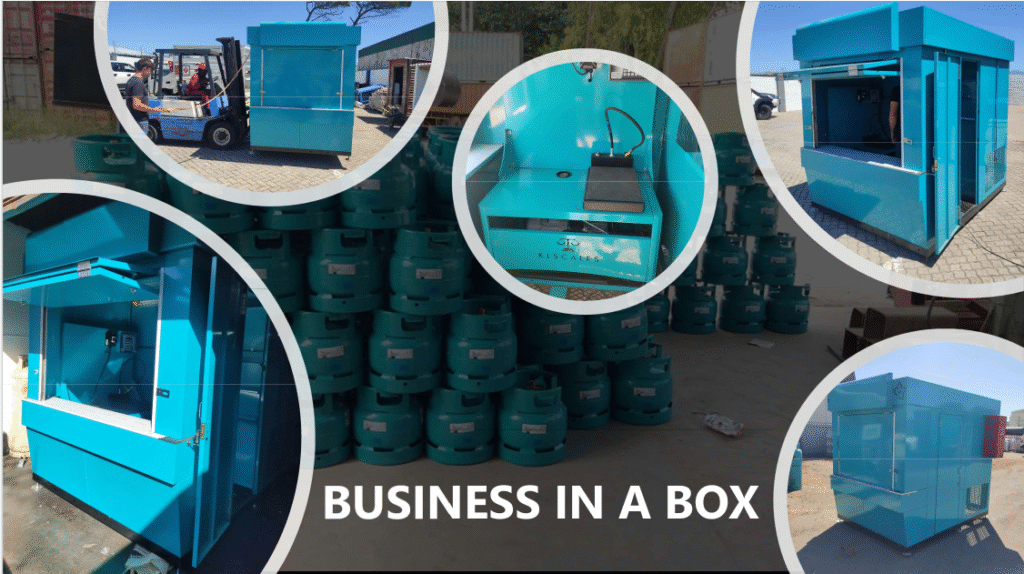
Go-to-Market Strategy for “Business in a Box”
The “Business in a Box” concept is a complete, ready-to-operate LPG microstation designed as an all-in-one turnkey solution for aspiring entrepreneurs. It includes a custom-built, weather-resistant steel kiosk, an integrated LPG scale system, internal piping, electrical points, secure storage, and safety features. This initiative aims to empower local entrepreneurs by simplifying entry into the LPG market, making it accessible even with limited capital and reducing traditional barriers like infrastructure and regulatory hurdles.
1. Target Market Identification
The primary target markets for “Business in a Box” are:
- First-time Entrepreneurs in under-resourced or rural areas, particularly within townships across Cape Town and potentially extending nationwide. Examples include unemployed individuals like Thabo Mthembu who was struggling to make ends meet, or former taxi drivers like Sipho Ndlovu looking for new opportunities.
- Existing Small Businesses looking to diversify their income streams.
- Women Entrepreneurs seeking to enter a traditionally male-dominated industry, leveraging success stories like Nomsa Jacobs.
- Communities seeking safer and more accessible energy solutions, especially during load-shedding and economic hardship.
- Unemployed Youth through future youth apprenticeship programs linking them with established operators.
2. Core Value Proposition Messaging
The messaging should clearly articulate the transformative benefits of the “Business in a Box”:
- “Your Pathway to Economic Independence and Community Impact”: Emphasize that it’s more than just equipment; it’s a launchpad for dozens of residents to build successful energy businesses and create livelihoods. Highlight its role in job creation within local communities (e.g., Sipho employing two local youth).
- “Effortless Entry into the Energy Sector”: Position the “Business in a Box” as a low-risk, high-impact starting point that is “plug-and-play”. Stress that it provides the professional setup needed for dignity and safety, as seen with Marcus Johnson’s story.
- “Reliable Energy, Community Resilience”: Focus on how these microstations become “lifelines” during load-shedding, enabling families to cook and small businesses to operate. Highlight improved LPG access in underserved regions, contributing to energy security.
- “Partnership for Success”: Underscore PCT’s commitment to ongoing support, including comprehensive training (safety, business management, customer service), technical support, and business development guidance.
3. Distribution and Sales Strategy
Leverage existing community ties and PCT’s unique partnership approach:
- Community-Centered Outreach: Given that these are “neighbors serving neighbors”, focus on local engagement.
- Direct Presence in Townships: Conduct information sessions and workshops in high-potential areas (e.g., Khayelitsha, Mitchells Plain, Gugulethu, Nyanga) to introduce the concept and its benefits directly to potential entrepreneurs.
- Partnerships with Local Leaders and Organizations: PCT already helps entrepreneurs build relationships with community leaders. Deepen these partnerships to identify and vet potential entrepreneurs and integrate with local economic development initiatives.
- Showcase Existing Success Stories: The “multiplier effect” of success spreading organically is already evident.
- “Open House” Events: Organize events at successful “Business in a Box” locations, allowing prospective buyers to see operational units and hear directly from thriving entrepreneurs like Thabo, Sipho, and Nomsa.
- Testimonial-Driven Marketing: Create short videos and written content featuring the entrepreneurs and their customers, focusing on the tangible benefits (e.g., serving over 200 families weekly, providing independence from electricity problems, inspiring other women).
- Online Presence & Direct Contact:
- Maintain a clear call to action on PCT’s website for “Business in a Box” inquiries, encouraging direct contact to “explore how their Business in a Box concept could launch your journey into energy entrepreneurship”.
- Utilize social media to share success stories, educational content, and invite inquiries, reaching a broader audience in South Africa.
4. Marketing and Promotion
- Emphasize Accessibility & Support: Highlight that the “Business in a Box” removes traditional obstacles to entry and that PCT offers ongoing partnership and training.
- Focus on Safety and Compliance: Differentiate from informal operators by stressing that PCT’s units provide a professional setup with proper scales and safety equipment. Emphasize PCT’s training in safety protocols and the benefit of increased energy safety standards in communities.
- Address Economic Realities: Promote the entrepreneurs’ ability to offer flexible payment plans and build local relationships to serve customers even when money is tight. Educate communities about safety and quality differences compared to cheaper, unregulated sellers.
- Showcase Community Impact: Emphasize the broader impact beyond profit, such as over 15,000 households with improved energy access and an average 40% reduction in energy costs for customers.
- Targeted Programs: Promote specialized training programs for women entrepreneurs and youth apprenticeship programs as part of PCT’s expansion plans.
5. Strategic Partnerships for Growth
- Financial Institutions: Explore partnerships with microfinance providers or banks to facilitate easier access to capital for potential entrepreneurs, addressing the initial investment hurdle.
- Government & Regulatory Bodies: Partner with community organizations and local government to understand local regulations and align with government initiatives to expand LPG infrastructure and access.
- LPG Suppliers: Continue to work with major LPG suppliers to ensure a reliable and efficient supply chain for “Business in a Box” operators.
By focusing on these strategic areas, PCT can continue to expand the reach and impact of its “Business in a Box” concept, empowering more South African entrepreneurs and communities.